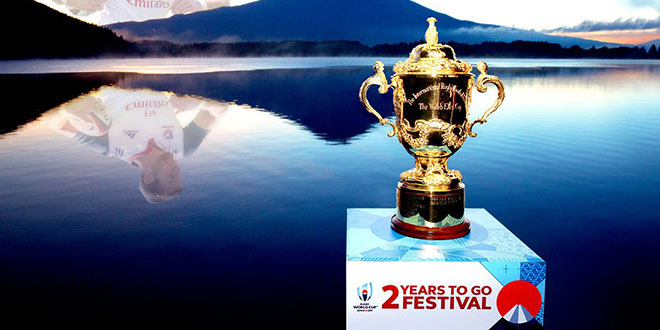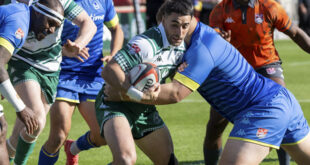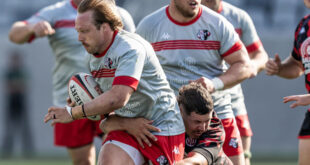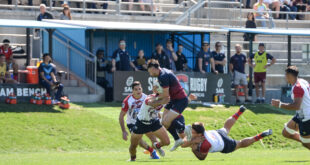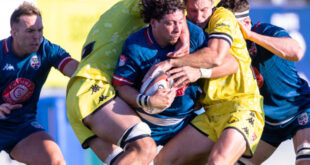There are now two years to go until the Rugby World Cup 2019 in Japan and while a lot can happen in that time, narrowing down squad selection will already be on the minds of international selectors with a finite number of elite level games available to fine tune and iron out deficiencies.
The Eagles are in a unique position having qualified as Americas 1 for the first time, giving them a full two years of preparation ahead of rugby’s flagship competition. Their pool will not be easy with England, France, Argentina, and Tonga alongside but they will enter as the best prepared Eagles team ever which could well lead to an surprise or two.
One obstacle has now been resolved somewhat. Just today their new Head Coach was confirmed to be Gary Gold, the South African currently in charge of Worcester Warriors. While he will not be fully committed to the team until next May, he should have a positive impact particularly given his willingness to reside in the USA on a full-time basis, something that outgoing John Mitchell could not give the team.
Another major shortcoming of American rugby – the lack of an elite domestic competition – is also on the right path to a possible resolution. Major League Rugby will begin in 2018 filling a gaping hole left by the dissolving of PRO Rugby. While the standard of play itself will be a work in progress, the opportunity for players to be in a daily training environment will be of immense value to fringe players.
In the immediate calendar is the Americas Pacific Challenge, a three-match tournament for the Select XV (aka ‘A’ side), before a two-match tour to Europe in November. The Americas Rugby Championship returns in February, with a similar calendar in place for 2018. In total there looks to be 27-30 games between the Selects and Eagles ahead of Japan.
In the first of a two-part analysis we look at who was involved at Rugby World Cup 2015 and how the team might look in 2019. Some positions look set in stone but others are very much up for grabs and the clock is ticking for hopefuls to make their mark. First up, the forwards.
THE FRONT ROW
It’s unusual times for the Eagles, who after years of scraping to find even a first choice trio now have options in the front row, and professional options at that. Even below the senior training squad there is depth starting to bubble up and with a bit of work on the technical side of things there could be players on the edges of the selection chart right now who could squeeze into a seat on the plane in 2019.
The scrum has improved noticeably since 2015. Against top opposition, however, it remains a concern. A shift in focus and concerted effort from both coaches and players must come to address this problem. Mobility in unstructured play is a disireable trait but cannot come at the expense of a stable set piece.
One significant issue that seems to be heavily prevalent in American rugby is the tendency for props to play both sides of the scrum. In the modern game this should be the exception rather than the rule. If we extend the player pool to the top dozen or so props, only Eric Fry, Chris Baumann, Dino Waldren, and Paddy Ryan are truly specialists. It’s thus no surprise to see them at the top of the charts.
RWC 2015 (age at tourney start)
LH Prop – Eric Fry (28), Olive Kilifi (28), Joe Taufete’e (23)
Hooker – Zach Fenoglio (26), Phi Thiel (30)
TH Prop – Chris Baumann (28), Titi Lamositele (20), Mate Moeakiola (37)
The 2015 cast largely remains but the pieces have shifted somewhat. Chris Baumann has improved such that he is now on contract with Leicester Tigers, allowing Titi Lamositele to switch back to his favored loosehead side. Olive Kilifi has gone the other way, now focusing on the tighthead role. Big Joe Taufete’e is now with Worcester Warriors and can cover loosehead but plays exclusively hooker in the Premiership. Eric Fry fell out of favor with departed coach John Mitchell but is in a rich vein of form with Vannes in the Pro D2 at the moment that should see him recalled. Mate Moeakiola has since retired.
There is a changing of the guard at hooker. Phil Thiel is another who has hung up the boots. Zach Fenoglio meanwhile remains among the best hookers in the nation but has opted out of international contention since the World Cup and looks unlikely to change his mind.
Stepping into the fold are Australian-born James Hilterbrand and Peter Malcolm, both competent players who can be classified as professionals though not currently in top flight divisions. Hilterbrand is the more experienced of the two with Malcolm an athletic up-and-comer with high potential. Those two are odds-on to carry through to the World Cup along with Taufete’e.
Alternatives could be New Orleans native Cam Falcon, who can be considered fourth choice at the moment, and Alex Vorster of Saint Mary’s. Other names of interest are PRO Rugby standouts Jay Finau and Irish-born Dylan Fawsitt, the latter of whom is just now completing his residency requirements.
The prop ladder is muddy, very muddy. Those at the top appear to be a clear step ahead of the rest. Dino Waldren enjoyed his stay in Ireland and is now at London Scottish, while former Newcastle tighthead Paddy Ryan threw his hat in the ring just this past June and is currently on trial at Bath. Lamositele and Baumann, when fit, are first choice and it would be a surprise not to see Fry back with the squad soon.
As it stands those five European pros are in pole position for 2019. Anthony Purpura is enjoying something of a revival and has looked good in spots, and the much younger Alex Maughan is on the radar but neither are strong betting favorites. Ben Tarr missed out on 2015 with a knee injury and is likely the next cab off the rank but is destined to be a squad player without settling at either loosehead or tighthead. Valdemar Lee-Lo looked full of promise with the Sacramento Express but has himself struggled with injury and is another stuck between two sides of the scrum.
Another Australian, Luke White, was close to the best loosehead in PRO and is now back in Glendale colors after missing the best part of a year following ACL reconstruction. He is big, physical, and will be qualified for the Eagles in time for the upcoming Americas Rugby Championship. On the other side for Glendale is Kelepi Fifita, back in rugby following his collegiate football sojourn. He has shed some excess weight and impressed with his powerful carrying game. Fifita looks more of a long-term project for now but is one to watch.
Others who are probably less likely at this point include Angus MacLellan, often around the senior squad but never quite breaking through. He seems to prefer tighthead but plays both sides. An out-and-out big man on the right side is John Hayden, who looks set to make his international bow in Montevideo.
RWC 2019 (age at tourney start)
LH Prop – Eric Fry (32), Titi Lamositele (24)
Hooker – Joe Taufete’e (27), James Hilterbrand (30), Peter Malcolm (25)
TH Prop – Chris Baumann (32), Paddy Ryan (28), Dino Waldren (28)
THE SECOND ROW
Lock is a position that has traditionally been defined by individuals for the Eagles. Names like Kevin Swords, Luke Gross, and Alec Parker stand out but the rest have largely been honest toilers. Size has rarely been an issue, it’s quality and particularly grunt that has been left wanting from the engine room. The current generation look to be a step in the right direction.
As with the front row, a lack of clarity in selection has slowed progress to now. Players have moved between the second and back rows freely with not enough respect given to the position’s importance at the scrum. This was a major shortcoming heading into the 2015 World Cup but thankfully that trend is beginning to shift, though there remained a couple exceptions under Mitchell.
RWC 2015
Lock – Cam Dolan (25), Greg Peterson (24), Hayden Smith (30), Louis Stanfill (30)
The shed should be completely retooled for 2019. Hayden Smith and Louis Stanfill have retired and Cam Dolan looks to be left where he is most effective in the back row. Greg Peterson was the biggest man on the roster and is now a vital player in the Eagles scrum provided they can get him on the pitch.
Three men in the same stratosphere are Siaosi Mahoni, Matt Jensen, and Nick Civetta. The former is still a youngster at only 20 but is a monstrous specimen that should benefit significantly from his contract with Narbonne in France. Jensen is a fair wedge lighter but still a physical specimen who also showed real potential in the ARC. Civetta has had a breakthrough season after working hard at Newcastle and is very close to cementing his trip to Japan. He is the best lineout jumper available and his work rate around the pitch has improved significantly.
One of the most interesting prospects is Ben Landry, two inches shorter at 6’6” (1.98m) but an explosive athlete. Back in rugby after an attempt to make the NFL as a tight end, Landry has an ideal physique for a lock, is effective in the lineout, and very rarely if ever comes second best in the contact area. With two years to go there is time to make significant upgrades to his rugby knowledge. Nate Brakeley is a little smaller but now sports a more muscular physique than he had when he first emerged on the test scene in the 2016 ARC. He is an intelligent player with a big engine who can’t be counted out.
One decision that the new coach will have to make early is whether to consider Samu Manoa as a loose forward or a lock moving towards 2019. He’ll be 34 at the time and while his clout in the tackle area is unlikely to diminish his speed across the park may be best suited for the engine room. A more likely situation is that he is used as bench reserve to cover both spots with a specialist openside alongside.
Two uncapped France-based youngsters on the outside looking in are Victor Comptat and Christian Ostberg. Now plying his trade at Massy Essonne, Comptat is a towering lineout forward but only 21 years old and needs time to add bulk to his frame. Ostberg, at Aurillac, is two years older than Comptat and not as tall but a good athlete and has already appeared for the USA Select XV. He will be of interest to the incoming coach but it could well be on the side of the scrum where he is most useful.
Competition for these spots will be hot. Peterson, Civetta, and Landry look strong bets for 2019 with Manoa’s squad placement to be decided. Jensen, Brakeley, and Mahoni make up the ‘possibles’ group at the moment with Ostberg also there or thereabouts.
RWC 2019
Lock – Nick Civetta (29), Ben Landry (28), Samu Manoa (34), Greg Peterson (28)
THE BACK ROW
Big, strong athletes have long been a strength of the Eagles when it comes to loose forward selection. While there is an ever-increasing pool of talent to choose from, finding truly dominant players in the back row has been surprisingly difficult outside of Samu Manoa. With Todd Clever now retired and Manoa on the wrong side of 30, the back row options look solid but unspectacular at the moment.
Some of the issues that have challenged the team recently include a lack of a top class fetcher at openside and questions over balance across the back row. Finding players who can link with the backline instead of being out-and-out crash ball merchants hasn’t been easy and there has been a glut of players who could be viewed as ‘6.5’ type flankers or all-round loose forward types rather than specialists.
RWC 2015
Flanker – Danny Barrett (25), Andrew Durutalo (27), Al McFarland (26), John Quill (25)
No 8 – Samu Manoa (30), Matt Trouville (29)
There should be a major shift in the back row come RWC 2019. Al McFarland has been leap-frogged by several players and Matt Trouville already has a step through the door into full-time coaching. Samu Manoa is aging and while still likely to be in the picture could be seen more as a lock. Andrew Durutalo has left the 7s program and looks a certainty to be a key player over the next two seasons, while John Quill remains in the mix and a decent bet for Japan.
The future of Danny Barrett in the XVs side looks cloudy. There are no questions of his ability but the physical requirements and technical differences between the two codes at international level are substantial. For him to challenge for a spot in the side for 2019 Barrett will need to commit to XVs fully a year out, which seems unlikely given the build-up to the Olympics just a year further down the road. The days where players jump back-and-forth between 7s and XVs is nearing an end if not already here.
New Zealand-based Tony Lamborn has emerged as one of the USA’s best loose forwards since committing in 2016. He looks a probable for 2019 along with Durutalo, who is in top form with new club Ealing the moment as an openside. The question is whether the new coach will look to play them both, with Durutalo capable across the back row, or keep one on the bench with other options available on the blindside and at No 8.
Employing a strong ball carrier at the back of the scrum will be a priority. Durutalo can fill that role but there are others probably better suited. Manoa is certainly one of them, another is incumbent Cam Dolan. Now at Old Blue in New York after departing Cardiff Blues, Dolan hasn’t quite hit the heights most imagined he would but there is still time. After being shunted around in the pack with time at lock and on the blindside, he looked impressive in his preferred No 8 spot in the ARC and should stay there moving forward. Dolan is more a link player than an imposing gain-line operator and how the new coach wants to play could well dictate whether or not he is first choice moving forward.
If Manoa or Durutalo are not seen as ideal options a similar profile is that of David Tameilau. Criticized in the past for being unfit, he returned to Eagles duty in the ARC and proved arguably the most damaging ball carrier in the competition. Now at Narbonne in France he is also occasionally employed as a lock but is far more comfortable in the back row. Langi Haupeakui was a hot topic just a year ago but has all but dropped out completely after leaving Glasgow and returning to the Bay Area. Could he return to prominence in time?
A completely different style of player is Sebastián Kalm. One of the hottest properties in the Americas will be playing for the NOLA Gold in Major League Rugby and the Chilean-born PRO Rugby MVP has stated his intention to earn a spot in the Eagles after qualifying on residency. He can play across the back row and while he isn’t the biggest player, his immense work rate and footballing ability make a very interesting prospect. Expect him to be included in the 2018 ARC side.
Among the recent graduates of the Junior All-American program is flanker Malon Al-Jiboori, like Kalm a standout at Lindenwood and another with the ability to contribute across the back row without being type-cast. Maciu Koroi at Life is a dynamic player who specializes at No 8 but having not yet made a senior side is a longshot for 2019.
One of the USA’s brightest young talents is Hanco Germishuys, a South African-born flanker who plays in Austin. He briefly flirted with a move to hooker but it’s in the back row where he is most effective and where he should put huge pressure on incumbents like Lamborn and Quill. Seattle’s Aladdin Schirmer is less destructive, another link player, and yet another whose best position seems to be undecided.
If the new staff moves towards a more traditional flanker combination there could be consideration given to the aforementioned Christian Ostberg and newcomer Jackson Kaka. Ostberg has the size of a lock but the athleticism to play on the blindside and would be a strong lineout option. Kaka is also physically imposing, a native of New Zealand who played both football and rugby at BYU. He will get his first look in a USA jersey in Montevideo in the Americas Pacific Challenge.
A number of other players have been in and around the squad and others could yet emerge from Major League Rugby or elsewhere. Psalm Wooching, for instance, has played one game at flanker and who knows where he might be a year from now. Choosing six from the group at this point is likely an exercise in futility but those below might be considered slight favorites at the time being.
RWC 2019
Flanker – Andrew Durutalo (31), Sebastián Kalm (26), Tony Lamborn (28), John Quill (29)
No 8 – Cam Dolan (29), David Tameilau (29)
SUMMARY
Finding the right mix in the back row and putting a priority on the scrum in the tight five look to be the most pressing issues for the Eagles heading towards 2019. Something that could also influence selection is whether the new coach opts to take a younger player rather than a technically superior choice with an eye towards the 2023 World Cup.
A clear decision will have to be made early on whether success – or perceived success – is the priority in Japan or a longer-term approach is seen as more valuable to USA Rugby. If the latter is chosen, it could mean senior players who are not first choice are left out as non-travelling reserves.
A detailed Player Pool for the Eagles can be seen here.
 Americas Rugby News Rugby news from across the Americas!
Americas Rugby News Rugby news from across the Americas!
